Everything until this point of Final Fantasy VI — approximately 45 minutes of play time — has been a sort of prologue that doubles as a subtle tutorial. But now that you’ve made your way into Narshe and back out again, you have the opportunity to experience a genuine, overt, no-bones-about-it tutorial section. These training houses appeared first in Final Fantasy IV and continued through Final Fantasy VII, which really makes sense as those four games represent a very specific phase in the series’ life that ended when Final Fantasy VIII came along.
The tutorial house is completely optional, but it’s incredibly valuable. These guys, who either have big blond bouffant ‘dos or else are wearing ‘coonskin caps, offer you play advice and details on many unintuitive mechanics.
Some of what they pass along is standard RPG lore.
While others have to do with how FFVI specifically presents standard mechanics. Character status effects — both positive and negative — are denoted not with icons or text pop-ups in this game but rather by changing the coloration of the black outlines around the afflicted sprite.
The tutorial room is worth the price of admission for this tidbit alone. At no point in combat is the fact that you can hit the shoulder buttons to change spells from single- to multi-target self-evident, but this is a tremendously valuable piece of advice that can save both time and magic points; if you can wipe a party of enemies with a single multi-target spell, you don’t have to beat down each one individually, or spend the magic for multiple spells.
There’s even a room which is specifically designated as experts-only. Although you’ve already been forced to take part in several battles by the time you reach the tutorial house, which means you have context for most of the information you’re given here, much of the more advanced info is sequestered so as to minimize confusion.
In fact, there’s only one bit of dialogue that makes any sense whatsoever here: You’ve already come across Mog’s Dance command (at least potentially), so now you know (1) how it works and that (2) it’s not wholly unique. You can take notes if you like here, but eventually you’ll return to Narshe and can visit then — a fact that should be fairly self-evident given the way you didn’t actually destroy the city, and you’re actively blocked from exploring obvious interactive portions of the city.
For now, though, all you can really do is venture forward. There’s only so much to do in the tutorial house, and the guards continue to chase you away if you try and wander into Narshe.
Once you leave Narshe, the perspective changes, which can be a little confusing for a newcomer. This is another level of abstraction inherent to RPGs of this era: When you travel across the world, everything zooms out. You travel across a map, and regions you can enter and explore become represented as small icons. Unlike a lot of other RPGs, in FFVI you don’t venture out from an obvious castle or city or the like; Narshe is depicted as a small path leading into the mountains, which makes its iconography somewhat less than obvious.
Despite the visual difference, functionally this portion of the game works more or less like Terra’s solo walk through the caves. The overworld is, of course, much less maze-like; it largely consists of open spaces. And you can save freely (or use camping gear like tents and sleeping bags to restore the party’s health) at any point while in the overworld. You also won’t find treasure chests.
However, you will encounter random battles with new enemies. These battles work the same as in dungeons: Every step you take, there’s a mathematical chance you’ll be whisked into combat and forced to fight some sort of wildlife or other sort of marauder. The monsters you fight throughout the game vary according to your location, and the creatures outside Narshe are completely different from those inside the city and its caverns.
In this case, the monsters are nothing to sweat. I mean, there are bunny rabbits who ambush you from inside heads of cabbage. It’s not exactly intimidating.
Leaf Bunnies have two forms of attack: Basic weak attacks, and a skill called Incisors, which hit one and a half times as hard as a standard strike. The crows, called Darkwinds, are basically the same deal: They can attack or use a skill called Dive, which again confers a 50% attack bonus. But neither has group attacks, special counters, or weird behaviors. These creatures do have some specific affinities and status traits — Darkwind, being a flying enemy, permanently carries the Float status, making it immune to Earth-element attacks — but none of these matter right now. The one thing worth knowing is that both are weak to Terra’s Fire spell, which makes encounters like these a handy test case for the shoulder-button spell targeting feature.
As you roam through the overworld and encounter enemies on different kinds of land, you’ll find the scenery in the battle background changes to reflect the nature of the environs. This actually does have a functional gameplay purpose, but that comes much later; for now, it’s strictly aesthetic.
Well, mostly aesthetic. The territory in which you enter battle can have an impact on the nature of the enemies. Sand Rays, for example, will only attack in desert regions, while you’ll never encounters Leaf Bunnies in those areas. Never mind that in about 20 seconds of walking you can go from snowy mountains to shimmering deserts… like I said, the overworld is abstraction.
Would you be surprised to learn that Sand Rays can also use basic attacks and a special action called Tail that hits for 150% damage? Unlike all the other enemies you’ve faced in free battle so far, though, the item Locke can steal from Sand Rays isn’t Potions but rather Antidotes. They’re also about 50% more powerful than Leaf Bunnies and Darkwinds, and appropriately enough give more EXP upon their defeat. The further you roam from Narshe, the more powerful enemies become… but, generally speaking, the rewards for victory grow commensurately as well.
There are only a handful of places you can visit at this point in the game, but the most obscure is a patch of forest that turns out to be an interactive location: A chocobo stable. Chocobos are returning creatures from previous Final Fantasy games, and here they serve as steeds that allow you to travel rapidly across the map without fear of enemy attacks.
There’s a clever panning and rotation effect applied to the map when you ride a chocobo; rather than orienting itself with north toward the top per usual, the map becomes as immersive as the Super NES was capable of managing, with the world rotating around you as you turn and scrolling beneath you as you run. The effect is somewhat diminished on Game Boy Advance thanks to the washed-out colors and the shorter vertical height of the screen resolution, which causes the horizon and its concomitant fog to dominate the screen.
This can be a little confusing at first, so this is probably a good time to point out the mini-map overlay that accompanies overworld exploration. A small, super-zoomed-out version of the map sits translucently atop the overworld map screen, with the player’s position relative to the surrounding landforms depicted as a red dot and possible destinations blinking as points of white light. When you ride a chocobo, your forward orientation is depicted as a smaller red dot to help you maintain your bearings. It takes a little getting used to, but it works well enough.
Enemies can’t attack you while you ride a chocobo, so this is a safe and convenient way to find your next destination. Of course, the downside is that you don’t gain any experience or cash if you’re not getting into battles… and if you hop off the chocobo at any point, it’ll run off for good and you’ll be out 100 gil.
Ah, right, gil. We can talk about money next time….
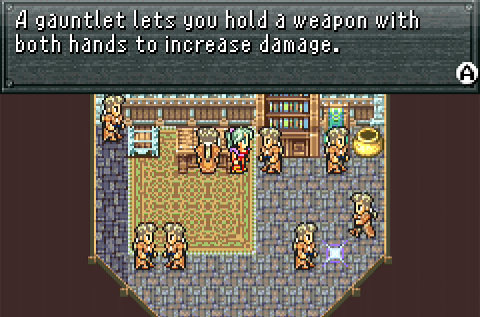
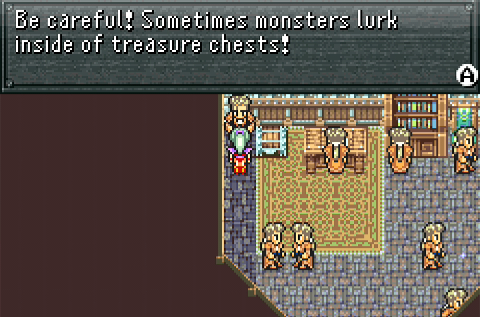

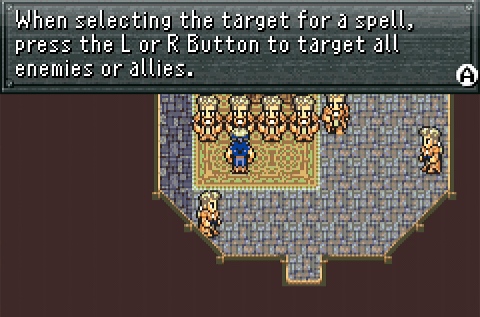
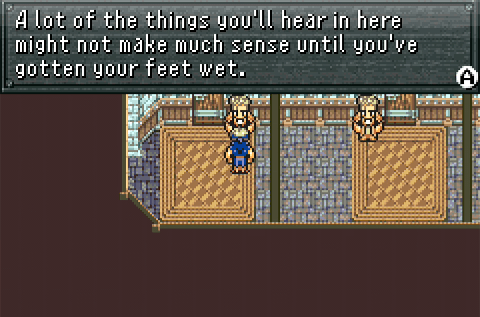

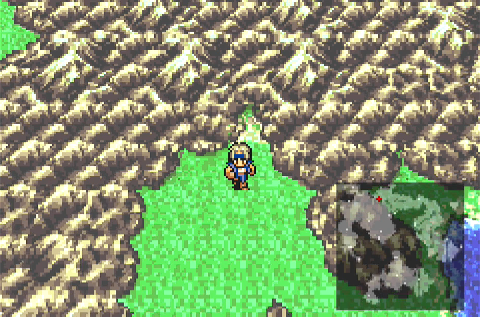


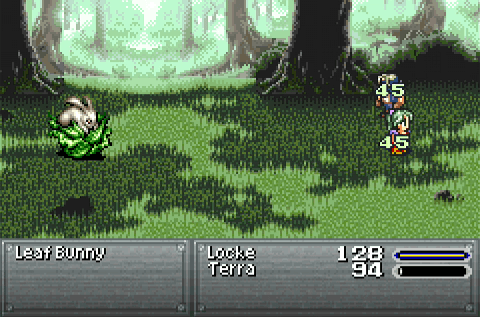



Maybe they’re “fancy lads.”
Come on, dude.
It’s a movie reference: Cabin Boy
I always liked the tutorial houses in Final Fantasy because they were a place where you could learn more about the game mechanics at your leisure instead of having tutorials for the most basic of basics forced upon you during gameplay. It’s like, once upon a time, game designers actually trusted the player enough to let them read manuals or chat with NPCs at their own leisure if they wanted to learn more about how to play a game.
Once upon a time, games had manuals.
I love the Leaf Bunnies because they remind me of a glitch later in the game. East of Kefka’s Tower in the World of Ruin, there’s a peninsula where they accidentally set the encounter list to the default, which means enemies from just outside Narshe.
Don’t worry everybody! The world has ended, but the Bunnies are okay!
Aren’t there a variety of situations where Terra can cast fire and amaze her onlookers?
Not until Edgar joins the party.
“which really makes sense as those four games represent a very specific phase in the series’ life that ended when Final Fantasy VIII came along.”
I’m playing through VIII for the first time since it was released and wasn’t prepared for how much it plays like a Beta-version of X. Far more interesting than good.
No mention of the changed theme when you hop on a Chocobo? I always thought that was pretty neat, even if it now pales in comparison to “SO YOU THINK YOU CAN RIDE THIS CHOCOBO”
I used to wander around the tutorial house for an excuse to hear the entirety of the main theme without staring at the title screen like an idiot.